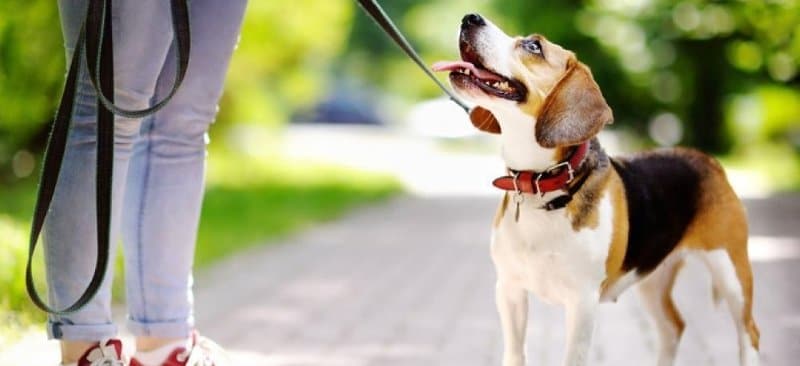The long-awaited moment has arrived. Your pup is finally home, and you can’t wait to go on your first walkies. This idyllic perspective may turn into a nightmare though if your dog starts pulling you from one direction to another.
If you want to avoid disappointment, arm yourself with patience, fill your pockets with delicious dog training treats, and find out how to educate your pooch to walk nicely.
Why Should Your Pup Walk On a Leash?
A common question among first-time dog owners, especially those who have a small breed dog.
The answer is simple. Regardless of your dog’s size and age, teaching your pooch proper behavior will make your walks a pleasure. Fido won’t pull like crazy when seeing another dog, cat or squirrel.
Leash skills will also help you command your pet when navigating through crowds or visiting the vet.
You can even decide when to keep him close and when to give him some room to sniff and explore the surroundings, making the whole walking experience less frustrating and safer for everyone involved.
Now that we’ve got that settled, here’s how to teach your pooch to walk politely on a leash.
Leash Training Basics: Getting Started

Whether you bought a brand new pup from a kennel or decided to adopt an abandoned – albeit adult – soul, you must know that all dogs can be trained to walk on a leash. The first thing you need is patience. Plenty of it, especially if you’re dealing with a stubborn pup or adult dog.
Then, make sure you have at hand all the items on this list:
- A fit collar;
- Leash;
- Dog training treats;
- A clicker.
Leash Training Step-by-Step

1. Introduce Collar and Leash
All puppies and most rescued dogs are unfamiliar with common dog attire. Leash and collar may be new to them, so the first thing is to introduce Fido to these items. Perhaps the best thing is to present the pup to the same accessories you’ll use daily.
A dog training collar could help you get through the training stage faster, and if you plan to use one, make sure you get the dog used to it too.
Let the dog wear both collar and leash indoors and avoid using the latter to correct improper behavior. The pooch must develop a positive feeling towards these items.
2. Introduce a Cue
A cue is a sound that lets Fido know the food’s on its way. It can be a word you say or the sound of a clicker. We recommend the latter since you can use this accessory for obedience training too.
Your pup will have no idea what the sound means until you teach it. Still indoors and with the pooch wearing his attire, use the cue sound to make the pup come to you. Reward behavior with a treat.
Your pup will quickly learn that cue sound equals food, so he’ll most likely abandon all distractions and run to you as soon as you make the noise.
3. Indoor Walkies
You now have all elements needed to start walking your dog. Pick up the leash and lead the pooch around your home. When he gets distracted, use the cue sound to make him follow you. Praise positive behavior and offer delicious goodies.
4. Outdoor Walkies
No matter how well-behaved your pup is indoors, getting outside brings new challenges. There is a whole new world of exciting stimuli out there, and even the most obedient breeds will tend to pull for the first times.
Your patience is key to success. Start with small walks and use the cue to get your pup’s attention whenever needed. Give him goodies when he stops pulling and when he walks beside you. At this stage, remember you must never correct inappropriate behavior with the leash. A dog training collar could help you apply small corrections if your pooch is too disobedient.
Common Issues and How to Solve Them

- Your dog won’t stop pulling: Walk the opposite way. This will determine your pooch to follow you. Praise him when he stops pulling and repeat as many times as necessary.
- Your dog rushes after things: Distract him before another target catches his interest and recompense good behavior.
- Your dog won’t walk beside you: Use a treat to make him walk side by side with you. Praise polite behavior and repeat until the pup learns to stay beside you.
